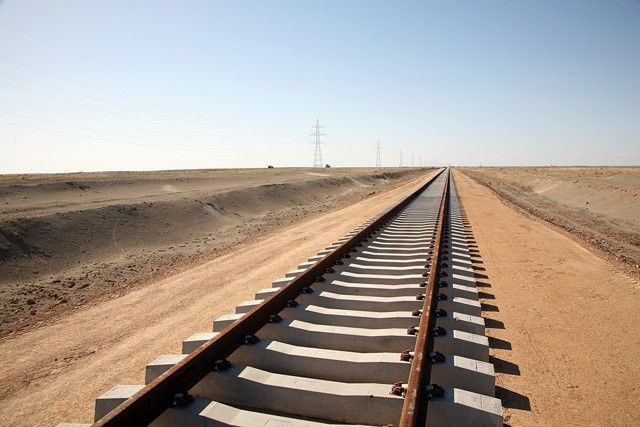BISHKEK (TCA) — After the China-Kyrgyzstan-Uzbekistan railway is constructed, Kyrgyzstan will have access to sea and become a transit country, Prime Minister of Kyrgyzstan Temir Sariyev said on Kyrgyz national radio this week. Currently, the railway track gauge is being discussed with the Chinese side, he added.
Construction of the railway will boost the Kyrgyz economy. In addition, relevant infrastructure will be created as part of the project. Up to 15-20 million tons of cargo per year could be transported through Kyrgyzstan. In the future, the railway can be extended to Iran.
The initial phase of the project is planned for 2016, said the Prime Minister.
The project will be implemented as part of the Silk Road Economic Belt Initiative proposed by Chinese President Xi Jinping during his visit to Astana in 2013. China and Central Asia should “join hands to build a Silk Road economic belt to boost cooperation,” Xi then said.
The feasibility study for construction of the China-Kyrgyzstan railway was completed late in 2015.
Route has been changed
The feasibility study has changed the route of the China-Kyrgyzstan railway. In 2012, an option route of a 430 kilometer railroad was developed providing for construction of 100 kilometers of tunnels and 60 kilometers of bridges. Tunnel is a costly construction with an average of $35-40 million for one kilometer.
Economic, technical, social and environmental issues related to the railway construction have been examined, as well as alternative routes. As a result, Kyrgyzstan has chosen a route consistent with its interests. The route will go close to populated settlements and the railway should be competitive with other railways in the region.
The route has been changed to reduce the cost of the project. According to the new version, the tunnels’ length has been cut by 30 kilometers, while the length of the road is now 40 kilometers longer. Along the route there are existing gravel roads, so there is no need to build additional technological roads.
Another important issue was the track width. The Kyrgyz side offered to build it according to the Russian 1520 mm width standard. Uzbekistan and Turkmenistan also use this standard. Through these countries, China plans to reach Iran and Turkey and then via the Caspian Sea to gain access to the European rail network.
The feasibility study of the railway was developed in accordance with the memorandum between the Ministry of Transport and Communications of Kyrgyzstan and the China Road and Bridge Corporation (CRBC).
On December 10, 2014 in Dushanbe the countries participating in the project signed a document on the route, size of the track, development of a feasibility study and identifying sources of funding.
Previously, Kyrgyzstan and China reached a preliminary agreement to fund the project on the basis of concession or creating a joint Kyrgyz-Chinese company.
The Kyrgyz side should provide land for the railway construction and the Chinese side the full financing of the construction of the railroad and infrastructure.
Kyrgyzstan’ authorities claim that construction of the railway will bring income to the economy and provide new jobs. Public organizations and analysts say that it will lead to illegal migration of Chinese citizens to Kyrgyzstan.
In fact, no one can guarantee that returns will be large. Given the absence of funds from Kyrgyzstan to build the railroad, the income from it will go to investors only. Employment of locals is also under question, because road-users themselves usually decide whom to provide with jobs and how much to pay.
Background
The idea to build a railway linking Kyrgyzstan and China appeared more than 10 years ago. However, the parties have not been able to agree on financial issues.
In 2013, the China-Kyrgyzstan-Uzbekistan railway project was frozen by Kyrgyz authorities and an agreement was not signed by the heads of China and Kyrgyzstan during Xi Jinping’s visit to Bishkek. Experts suggested that the main reason was the position of Russia which did not approve the selected rail gauge standard. Then, of the two options, the European and Russian, China had chosen the European gauge of 1435 mm.
Russia proposed its own railway project, Tajikistan—Kyrgyzstan— Kazakhstan—Russia, in May 2013 at the Collective Security Treaty Organization (CSTO) summit in Bishkek.
This issue was not directly related to the CSTO tasks, but the presidents agreed to instruct relevant departments to discuss the economic and financial feasibility of the project, CSTO Secretary General Nikolay Bordyuzha said.
It was assumed that the new railway would bypass Uzbekistan, apparently because the country had withdrawn from the CSTO.
Just an intention
However, such a project does not exist as yet because it is just an intention to develop long-term transport sector programs in these countries, Tajikistan’s Transport Minister Khairullo Asozoda said recently. There was only one meeting of relevant agencies of the four CSTO member countries in Moscow and no further discussions, he added.
Earlier it was reported that the railway could be extended to Afghanistan, Iran and Turkmenistan.
Tajikistan believed that a railway from Kyrgyzstan to Afghanistan through Tajikistan could give an additional powerful impetus for its economic development and solve its transportation problems as the railway would bypass Uzbekistan.
Another party interested in establishing a transport corridor through Tajikistan northward is Afghanistan, but it is not a CSTO member.
Construction of the Russia-Kazakhstan-Kyrgyzstan-Tajikistan railway is possible technically but requires too much funding. Experts believe that Russia will not benefit much from this project but it could strengthen Russia’s position in Central Asia.
So it is possible that the project could be shelved for a long time, and much would depend on both the geopolitical situation and economic problems faced by Russia.
For Kyrgyzstan, it will be good if at least one transnational railroad goes through its territory.









